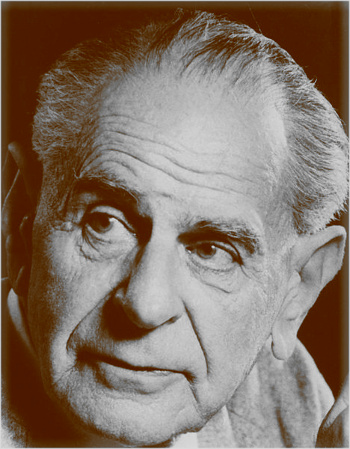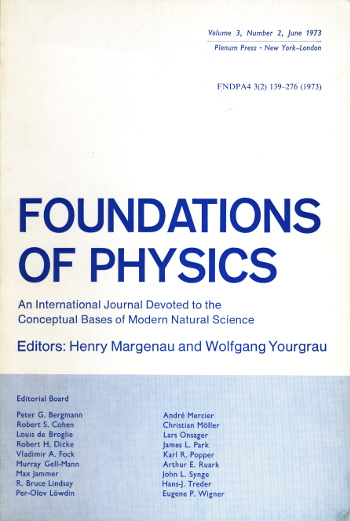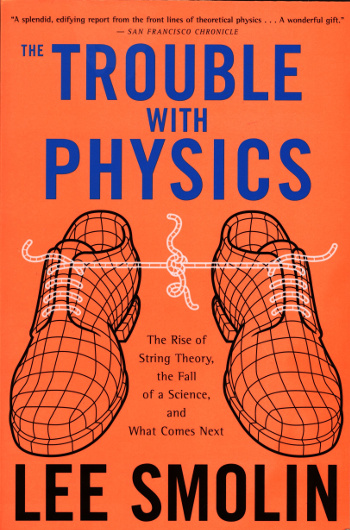Falsifiability
September 15, 2016
The
scientific models of my early
career were different from those of today. They were written more as
ink on
paper than as
electrons in
computer memory, so they were quite simple. One
experimentalist at our lunch table recalled how he had
co-authored a
paper with a
theoretician. The theorist's role was to summarize the
experimental data in an acceptable framework; in this case, an extended
RKKY model.
When the experimentalist noted that his data points didn't align with the theoretical
curve, his co-author told him not to fret. There were certain
parameters in the
equations that could be adjusted to give a desired result. In short, the model was
predictive in the fact that it gave you a number, but it wasn't predictive in the sense that it gave you the right number.
We all had a big
laugh at the lunch table, but at the heart of this
anecdote is a
principle that scientists have held for most of the modern era. That's the concept of
falsifiability. A
theory is only considered to be scientific if you can prove it to be false by some observation or
experiment.
Only in the last few hundred year has a distinction been made between science and
philosophy. Science was called "Natural Philosophy" when
Isaac Newton flourished.
William Whewel, who was the first to call practitioners of
physics, "
physicists," coined the term, "
scientist," in 1833. The term "science," as in what today's scientists do, has been used only since the 1870s.
While the idea of falsifiability was a part of scientific thinking much earlier, it was codified as the core of what's really science by philosopher,
Karl Popper (1902-1994) in 1934. In that year, Popper published the
book, "Logik der Forschung. Zur Erkenntnistheorie der modernen Naturwissenschaft" (The Logic of Research: On the Epistemology of Modern Natural Science), that was later revised as an
English edition,
The Logic of Scientific Discovery, in 1959.

Popper was born in Vienna, and he received his Ph.D. from the University of Vienna. Because of political conditions at the time, he found that it was necessary to emigrate to New Zealand in 1937, then to England after World War II. He was a professor of long standing at the University of London.
(Wikimedia Commons image, modified for artistic effect.)
From the
Renaissance through the modern era, the accepted
scientific method was the
inductive approach championed by
Francis Bacon (1561-1626). In this method, what's important is obervational evidence, and a lot of it. When there is enough evidence to be generalized, this generalization can be stated as a theory or a
scientific law.
Inductivism gave rise to many useful theories, and scientists of that period and well beyond had no problem with such a model. However, travelling on the tails of the scientists'
laboratory coats were a plethora of
pseudoscientific disciplines that proposed scientific theories based on their observations. In this camp would fall
astrology,
phrenology,
dowsing, and various forms of
medical quackery.
Falsifiability was Popper's solution to the
problem of how to distinguish science from pseudoscience. This problem was addressed at the same time by
sociologist and
philosopher of science,
Robert K. Merton (1910-2003), who proposed a set of five distinguishing attributes of a science.
• Originality - This is likely the least original of Merton's attributes, but it does make the point that your science should be something worthy of your life and career.
• Detachment - Science should be impersonal, and scientists shouldn't be concerned whether their experiments show one result, or another. As I've written in other articles, this is often difficult, since a scientist might have developed a theory, only to find contrary evidence mounting against it.
• Universality - Everyone should be allowed to do science, not just an Ivory Tower class.
• Skepticism - Scientists should always be open to contrary results, and should never casually discard those data points that fall off the curve.
• Accessibility - Scientific results should be published, and enablers such as reactants and computer codes should be shared. There is also a current trend for publication of the results of all clinical research, not just those that confirm the efficacy of a certain treatment. Also, raw data, when requested, should be presented, since different methods of analysis might lead to different conclusions.

Cover of Foundations of Physics, vol. 3, no. 2 (June, 1973), pp. 139-276.
This journal, still published, had Karl Popper on its editorial board, along with such notables as Louis de Broglie,Murray Gell-Mann, Lars Onsager, Eugene Wigner, and one of my professors at Syracuse University, Peter G. Bergmann.
(Scan of my copy.)
The concept of falsifiability has gotten a lot of attention in the last
decade with the rise of
string theory, an elegant
mathematical framework that's been applied to physics as the latest attempt at a
Theory of Everything. The allure of string theory is that it might be a way to
unify quantum mechanics and
general relativity. The problem is that it might never be possible to test string theory, so it can never be falsified. I wrote about this problem in an
earlier article (Not Even Wrong, July 29, 2008).
This
controversy about string theory's testability became heated in 2006 with the publication of
Lee Smolin's book,
The Trouble with Physics.[1] This indictment of
String Theory as a detour from "real" physics that's entrapped hundreds of theoretical physicists was further amplified by
Peter Woit's book,
Not Even Wrong.[2] The title of Woit's book derives from
Wolfgang Pauli's famous
assessment of a proposed physics theory.

The cover of "The Trouble with Physics" by Lee Smolin.
Joseph Polchinski, a string theorist and author of a textbook on the topic, String Theory,[3] published a combined review of Smolin's book and Woit's book.[4]
His conclusion was that "In the end, these books fail to capture much of the spirit and logic of string theory."[4]
(Scan of my copy.)
If string theory actually predicted some of the fundamental features of our
universe, or appeared to be close to doing that, all of physics would cheer. This theory of "everything," however, is presently a theory of "anything," since it predicts not just our universe, but
about 10500 others, each defined by its own self-consistent
vacuum state,
particles, and
forces.
The best explanation for the particular properties of our universe is that they're the only ones that allow the
evolution of an
intelligent life that
contemplates string theory. This idea is known as the
anthropic principle, and such reasoning is quite different from the predictive power of string theory's predecessor, the
Standard Model.
Perhaps the anthropic explanation is just an unfortunate blip in string theory
history. As the string theorists point out, the Standard Model was developed over half a
century; so, don't point fingers until we, too, have had our half century. I've always sided with Popper's principle of falsifiability, but some prominent physicists are willing to scrap this principle.[5] Falsifiability has kept me honest in my own science, but I do experiments, not theory.
References:
- Lee Smolin, "The Trouble With Physics: The Rise of String Theory, The Fall of a Science, and What Comes Next," Mariner Books (Reprint edition, September 4, 2007), 416 pp., ISBN-13: 978-0618918683. Also at Amazon.
- Peter
Woit, "Not Even Wrong: The Failure of String Theory & the Continuing Challenge to Unify the Laws of Physics,"Basic Books (Reprint edition, September 4, 2007), 320 pp, ISBN-13: 978-0465092765.
- Joseph Polchinski, "String Theory," Cambridge Monographs on Mathematical Physics, Cambridge University Press, June 20, 2005, 424 pp., ISBN-13: 978-0521672276 (via Amazon).
- Joseph, Polchinski, "All Strung Out? - a review of The Trouble with Physics and Not Even Wrong," American Scientist, vol. 95, no. 1 (January-February, 2007).
- Sean Carroll, "Falsifiability," Edge, 2014.
- Kate Becker, "Does Science Need Falsifiability?" Nova Blogs, PBS, February 11, 2015.
- Massimo Pigliucci, "Must science be testable?" Aeon, August 10, 2016.
- John Brockman, "Popper Versus Bacon - A Conversation With Peter Coveney, Edge, May 7, 2015.
- Nova: The Elegant Universe, October 28, 2003.
Permanent Link to this article
Linked Keywords: Science; scientific; mathematical model; career; ink; paper; electron; computer memory; experimentalist; co-author; scientific literature; theory; theoretician; experiment; experimental; data; RKKY interaction; RKKY model; curve; parameter; equation; prediction; predictive; laughter; laugh; anecdote; principle; falsifiability; philosophy; Isaac Newton; William Whewel; physics; physicist; scientist; Karl Popper (1902-1994); book; English language; The Logic of Scientific Discovery; Vienna; Doctor of Philosophy; Ph.D.; University of Vienna; politics; political; emigration; emigrate; New Zealand; England; World War II; professor; University of London; Wikimedia Commons; Renaissance; scientific method; inductivism; inductive; Francis Bacon (1561-1626); scientific law; white coat; lab coat; laboratory coat; pseudoscience; pseudoscientific; astrology; phrenology; dowsing; medical quackery; demarcation problem; sociology; sociologist; philosophy of science; philosopher of science; Robert K. Merton (1910-2003); originality; detachment; universality; Ivory Tower; skepticism; common good; accessibile; scientific literature; publish; reactant; source code; computer code; clinical research; efficacy; raw data; analysis; Foundations of Physics; Louis de Broglie; Murray Gell-Mann; Lars Onsager; Eugene Wigner; Syracuse University; Peter G. Bergmann; decade; string theory; mathematical theory; mathematical framework; Theory of Everything; unified field theory; quantum mechanics; general relativity; controversy; Lee Smolin; The Trouble with Physics; Peter Woit; Wolfgang Pauli; Not even wrong; Joseph Polchinski; textbook; book review; universe; string theory landscape; 10500; vacuum state; elementary particle; fundamental interaction; evolution; intelligent life; contemplation; contemplate; anthropic principle; Standard Model; history; century.